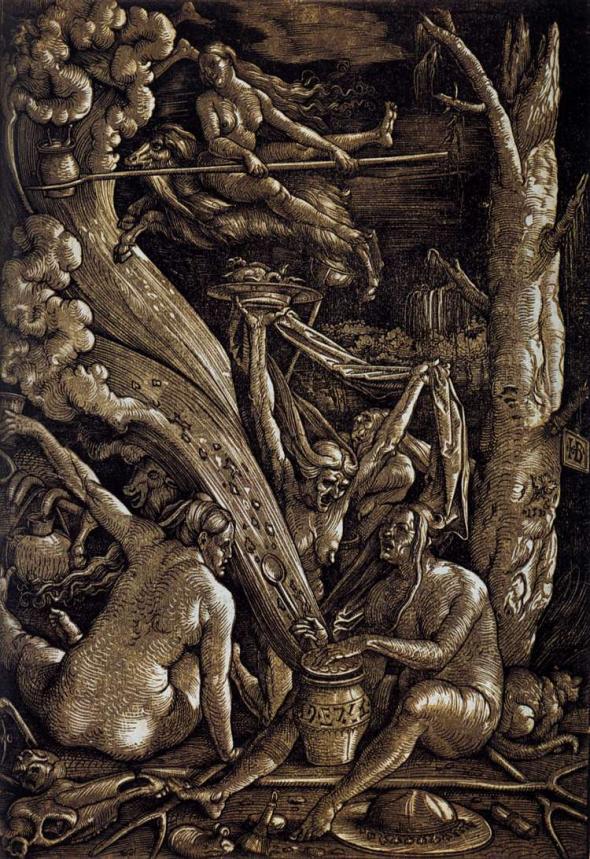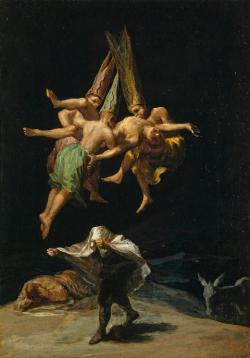Among the many odd moments in the very odd (and great) new horror movie The Witch is the closing title card, which notes that many of the preceding moments in the movie came “directly from period journals, diaries, and court records.” If that postscript came at the end of your average horror movie, you might suspect it of being just a fake-out designed to trick viewers into thinking that everything you just saw was real. But The Witch is not your average horror movie. Instead it’s designed to be, as the subtitle suggests, “A New England Folk Tale.” As writer-director Robert Eggers has said, he wanted the movie to feel like “a Puritan’s nightmare,” like what would happen “if I could upload a Puritan’s nightmare into the audience’s mind’s eye.”
Eggers has spoken often about how much research he put into achieving this effect, but what exactly did he find? We called him up to ask about some of the movie’s most shocking moments—demonic goats, baths of baby’s blood, and certain somethings suckling certain other somethings—and their real historical and literary inspirations. (Note: This interview is designed to be read after you’ve seen the movie.)
Why goats?
In England, goat farmers were really considered very backward. You did not want to be a goat farmer. It was not cool. But when the settlers came over here, they brought goats with them, and there was a lot of people with goats, because goats could clear the land very efficiently and they were small, to travel with. So, from early on, it made sense for the family to have goats.
The idea that goats are related to Satan is something that’s familiar enough from Goya—which is of course a later period—but in the early modern period and the late Middle Ages, in [the works of German artists] Hans Baldung Grien and Hans Holbein, we see all this stuff with witches and goats. I think that having the goat as a Satanic image in English witch narratives is more rare; it’s definitely more of a continental thing, and I think that hardcore witch historians would say that I might be pushing it a little bit. But considering that this family had goats, it seemed to work well.

Public domain/Wikimedia Commons

Public domain/Wikimedia Commons
How about the scene with the apple? Is that something you were borrowing from the Bible and the Garden of Eden, or was there a more specific point of reference there? I think a lot of us know Snow White.
Certainly Puritans would all be aware of the apple being synonymous with sin. But I read a book full of Elizabethan witch pamphlets, and there was an Elizabethan witch who was accused of giving children poison apples. This was earlier than any written accounts of Snow White that I’m aware of, and it’s really interesting to me how, in the folk tales and the fairy tales and the historical accounts of real witchcraft, the same themes and motifs come up. In all these stories, there’s no difference between the “real witch” and the “fairy tale witch.”
The big early reveal in the movie has a witch churning up a baby and then bathing in its blood—is that correct?

Public domain/Wikimedia Commons
What’s going on there is another thing that you see in some English texts, but which is more common on the continent: the idea that a witch couldn’t just hop on her stick and fly, but instead she needed an unguent, an ointment, to help her fly. I think even some modern witches today make flying ointments, and they have potentially hallucinogenic properties, which induce a state that makes it seem like you’re flying.
But the lore in the day was basically that the active ingredient of this unguent was the entrails of an unbaptized babe. And the baby, Samuel—given that his family was far from the settlement, and also given that the Puritans had weird ideas about baptism, he was susceptible to that.
We’re getting into increasingly grisly territory here, but there are scenes of people sucking blood from goat udders, and of animals lactating blood. Was that your image, or something that you drew specifically from somewhere else?
Yeah, witches very often would steal milk from farm animals, dry up the animals’ milk, turn their milk to blood, curdle their milk, and drink it. Sometimes they would take the forms of other animals to do that.
Also, witches had familiars, which were sometimes in demonic shapes and more often in the forms of everyday animals. The black cat that we associate with witches is a witch’s familiar. The witch, being an anti-mother, would feed these animals with her blood that came out of her nipples. [Note: This explains a certain scene with a raven that comes later.] Or sometimes the blood would come out of extra teats that she would have—potentially in her labia or in her anus. I’m not joking about this! This has been talked about a lot, but it didn’t quite make its way into the film.
I’m curious whether you have set ideas about what’s real in the movie and what isn’t—in other words, who’s possessed, and who might just be going mad?
I have very clear ideas about this. But I have intentionally tried to keep some mystery and enigma around that stuff, so I won’t share my opinions on it. It was designed with intentions, but also designed to be read in multiple different ways.
So you won’t tell us whether Thomasin was evil all along, or only becomes desperate at the end?
No offense, if that was anyone’s reading, but for people who think Thomasin was evil all along: “Once upon a time there was a story of a witch”—that’s the movie, and that’s not a very interesting story. So I will say that much.
But there are clues about different interpretations. So, for example, the rot on the corn is ergot, which is a hallucinogenic fungus, so if you wanted to take that route, you could. It’s not necessarily my route, but there are multiple ways in.
